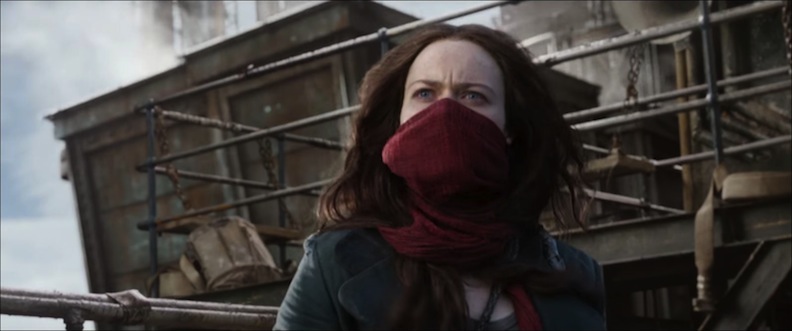
Hester Shaw is the scarred heroine of “Mortal Engines.” She proves that some scars are more than skin deep. (Movie photos courtesy of Universal Pictures.)
Available on HBO, as well as other streaming services, “Mortal Engines” is a big, loud, lumbering movie. Its scope is enormous, and its special effects are quite eye-popping. The film is filled with steampunk sensibilities that appeal to science-fiction enthusiasts and many BJD collectors. In fact, dolls play a major role in one of the character’s background story and his future ambitions. “Mortal Engines” was deemed a box-office failure, which is too bad. Though it is bursting to the gills with too many plots, some of its characters are worth revisiting. The dolls of “Mortal Engines” occur both on the set and off. They’re quite intriguing.
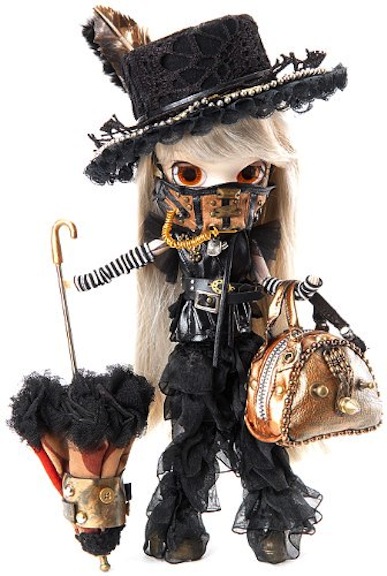
The Byul Steampunk Rhiannon doll from Pullip has an uncanny resemblance to the half-masked Hester Shaw.
Originally a series of successful novels, the book caught film director/producer Peter Jackson’s imagination. He and his wife, Fran Walsh, optioned the rights and waited nearly a decade before actually beginning the project. Along with their frequent collaborator Philippa Boyens, Jackson and Walsh penned the script. Rather than directing, Jackson turned the reins over to his storyboard artist Christian Rivers. Production began in 2017, and the movie debuted in November 2018. Most critics savaged it, and the dolls affiliated with “Mortal Engines” became cult collectibles rather than must-have tie-ins. Home streaming, however, gives viewers a second chance to see a financially failed project. Filmmakers are able to see their babies “reborn,” in a way.

Funko manufactured a line of “Mortal Engines” characters. Of course, Hester Shaw (shown here, unmasked) was prominent.
For the uninitiated, the plot of “Mortal Engines” revolves around a post-apocalyptic world set 1,000 years in the future. Cities are no longer tethered to the ground. Rather than remaining stationary fixtures, cities are built atop enormous wheels and travel about invading other traveling towns. London is the geographical star of the film. Set atop huge wheels, this once-great city now practices Mobile Darwinism. It hunts down less powerful, more vulnerable, enclaves; captures their people; utilizes their resources; then seeks another conquerable prey.

Talk about a city on the move! “Mortal Engines” tackles the philosophy of Mobile Darwinism. Here, Hester watches a dangerous city approach.
“Mortal Engines” sounds far-fetched and ridiculous, and, at times, it is. But amid this thinly veiled political commentary (Western civilization takes a beating), a tribute to dolls exists. Over the 1,000 years since the destructive 60 Minute War, different classes and breeds of life have evolved. One group of survivors is called Resurrected Men or Lazarus Beings.
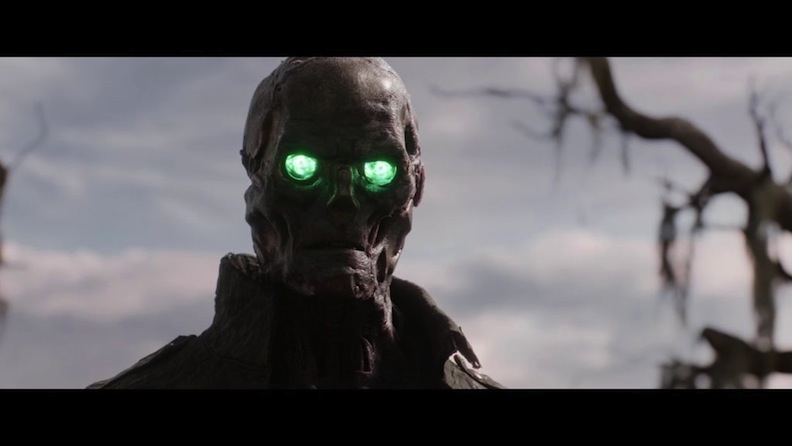
Shrike, the heart and soul of “Mortal Engines,” which is ironic. The Lazarus-like cyborg has no physical heart.
These are reanimated cyborgs that have a gleam of human consciousness in their skulls. However, the “human” part of them is not humane. They retain the most horrible, destructive, aggressive, and homicidal parts of their makers. Known as Stalkers, these zombielike robots were once the ultimate weapon. Now they are mostly forgotten and obsolete. Their fate is akin to the Sunbeam toasters that are discovered in a landfill at the movie’s start. Technology, no matter how cutting-edge, eventually becomes a relic.
Shrike is voiced by actor Stephen Lang, who has had a decades-long career. (Photo courtesy of 20th Century Fox)
The Stalker that pursues the movie’s heroine, Hester Shaw, is named Shrike. Voiced by Stephen Lang (“Avatar” is one of his major flicks), Shrike is the movie’s most compelling character. It is fascinating that the cyborg, who has no heart, is the heart and soul of “Mortal Engines.” Initially seen as a force from hell — he’s dogged like Schwarzenegger’s Terminator — Shrike reveals himself to be Hester’s faux father.
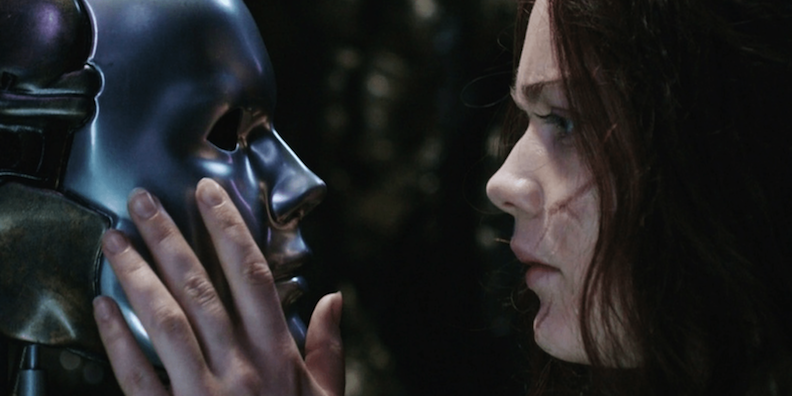
Shrike has sculpted a new body and visage for Hester. She comes face-to-face with her potential fate.
Orphaned, cast out of her home, and scarred by a ruthless madman, young Hester wandered alone until Shrike rescued her. The onetime killing machine brought her to his hideaway, a workshop filled with the body parts of dolls. He has spent his days tinkering with these doll heads, torsos, arms, and legs, trying to make a companion. As Hester grows up with this guardian/gadget, she discovers his secret. Somehow, a flicker of his past human life has remained in his consciousness. Shrike remembers that he had a son whom he loved. He has spent his life off the battlefield trying to build a little boy doll. This so-called cyborg wants a small companion in a red cap, like his long-ago son.

In “Mortal Engines,” Hester Shaw is seen as an adult and a child. Poppy MacLeod portrays the young, innocent Hester.
Icelandic actress Hera Hilmar plays the grown-up Hester, and Poppy MacLeod portrays Hester as a child. In montages, we see how Hester lived beside this Stalker, and how he managed to “feel” something for her. Shrike can sense that this young human girl has a broken heart, and he worries for her. Like many parents, he can’t bear the idea of her hurting. He exacts a promise from her; he wants permission to make her into a Stalker, too. In his consciousness, he makes a misguided equation. If Hester doesn’t have a beating heart, then she cant suffer a broken heart. This is where “Mortal Engines” is at its best. It reduces a father’s anxiety to the most basic premise and promise. Please, daughter, don’t grow up and abandon me. I don’t want to see the world hurt you and break you.
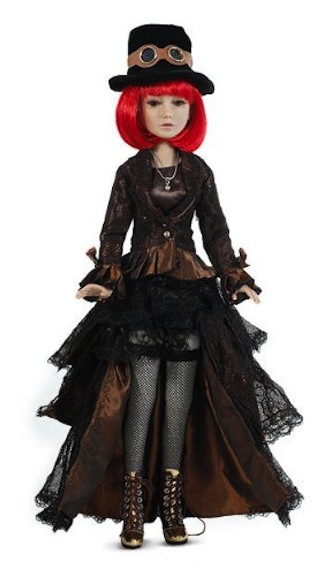
In 2011, Ashton-Drake/Bradford Exchange produced Delilah Noir. Here, the BJD is clad as a grown-up steampunk explorer.
Shrike’s worries and resolution are not attainable. The world has a way of upending the best-laid plans. Like John Lennon famously said, “Life is what happens to you while you’re busy making other plans.” In the time between Hester’s adolescence, under Shrike’s vigilant eye, and his discovering her 20 years later, Hester grew up. Like many other parents, Shrike has to accept a basic fact of life. Children grow up and grow away from a parent’s dream or vision. Shrike sees that Hester has the potential to use her heart. Hester is not a mechanical doll; she’s not a cyborg; she’s a 28-year-old woman.
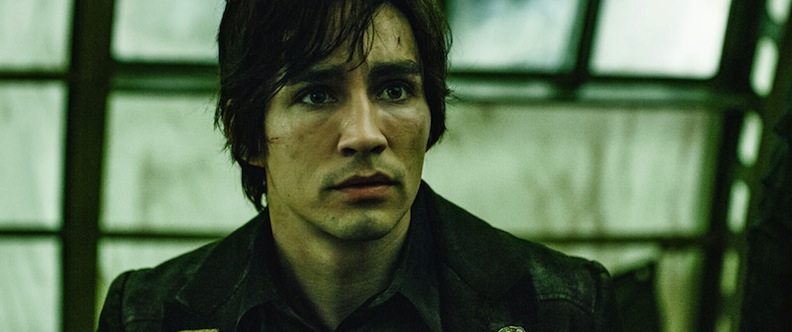
Irish actor Robert Sheehan portrays Tom, an apprentice historian who has his future changed by meeting Hester.
Most important of all, she has found a human soul mate. The Stalker makes a calculation, not a mathematical one, but a biological one. Shrike realizes that Hester can be happy with Tom Natsworthy (Robert Sheehan), an apprentice historian and aspiring aviator. The time Shrike spent surrounded by doll parts and distant memories has made him more human than he should be. His resurrected cyborg body has no physical heart, but he has a psychological one. He releases his surrogate daughter from her pledge.
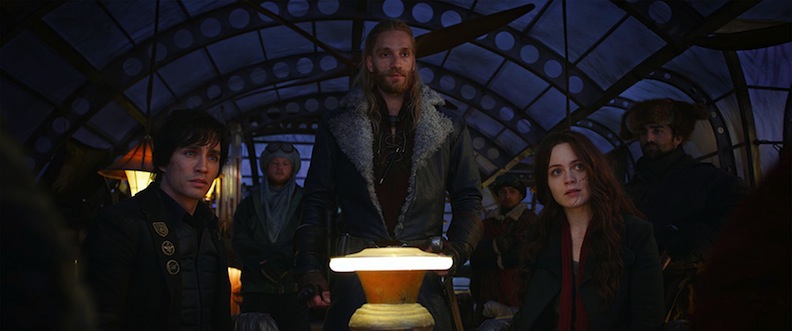
Like other post-apocalyptic screenplays, there is a ragtag team of fighters and resistors in “Mortal Engines.”
“Mortal Engines” has a million plots and subplots. There are battle sequences, and more battle sequences, and did I mention, there are battle sequences! However, the movie works best when it strips away the cacophony and the pyrotechnics. It is at its most interesting when it focuses on the bonds between the various Londoners and the other futuristic denizens.
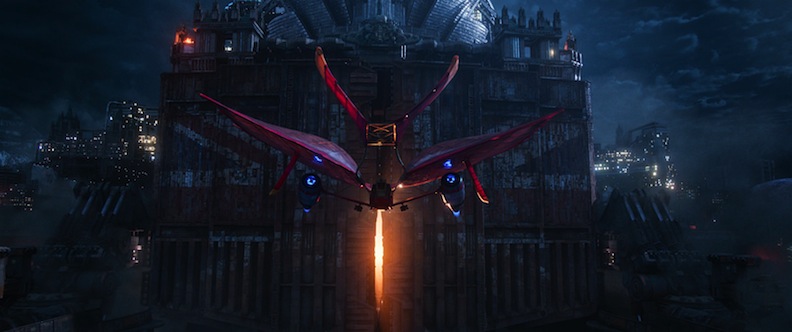
Dirigibles, zeppelins, and airships are a staple of steampunk. “Mortal Engines” has a variety of sci-fi flying galleons.
The steampunk costuming, the dirigibles, and the mood of the cities are reminiscent of Jules Verne or H.G. Wells. It is a delight for steampunk aficionados and can serve as fodder for faceup and makeover artists. Companies like Ashton-Drake, Tonner Dolls, Madame Alexander, and many others have traveled into the steampunk world with alternating success and failure. Independent artists have plied their skills to change recognizable dolls into steampunk adventurers. This movie has a ton of potential models.

A brand-new future? A brand-new destiny? Tom and Hester’s fate is interlocked in “Mortal Engines.”
Luckily, “Mortal Engines” can be streamed on HBO’s on-demand services. So, if the noise becomes too much, and the “too much” is too much, you can always fast-forward. Just follow the Hester/Shrike/Tom subplots. Those are enjoyable steampunk interludes and subtly personal, too.






